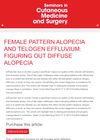Primary Care of Adult Women: Dermatologic Conditions
March 2016
in “
Obstetrics and Gynecology Clinics of North America
”

TLDR The document says that common skin conditions in adult women can be treated effectively, with acne being the most common and early-detected melanoma having a high survival rate.
The document from June 1, 2016, provides an overview of dermatologic conditions affecting adult women, including acne, alopecia, melanoma, dermatitis, and lichen sclerosus. Acne is the most common skin disorder, affecting 85% of people aged 12 to 24, with 40% of women aged 25 to 40 experiencing adult acne. Treatments range from topical retinoids to systemic antibiotics and isotretinoin, and the prognosis is generally good with treatment. Alopecia, particularly female pattern hair loss and telogen effluvium, is common, with treatments including topical minoxidil and spironolactone, and varying prognoses. Melanoma has a high survival rate if detected early, with a 10-year survival rate over 95% for thin tumors. Dermatitis, including contact and atopic dermatitis, is more prevalent in women, with half of AD patients experiencing symptoms at age 29. Lichen sclerosus, a chronic inflammatory condition, typically begins between ages 45 and 55 and is treated with topical steroids or macrolides, but can lead to significant scarring if untreated.











